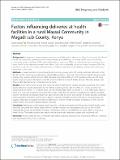Factors influencing deliveries at health facilities in a rural Maasai Community in Magadi sub-County, Kenya
View/
Publication Date
2018-01Type
Article, Journalviews
downloads
Metadata
Show full item recordCitation
Karanja et al. BMC Pregnancy and Childbirth (2018) 18:5 DOI 10.1186/s12884-017-1632-x
Abstract/
Background: In response to poor maternal, newborn, and child health indicators in Magadi sub-county, the “Boma” model was launched to promote health facility delivery by establishing community health units and training community health volunteers (CHVs) and traditional birth attendants (TBAs) as safe motherhood promoters. As a result, health facility delivery increased from 14% to 24%, still considerably below the national average (61%). We therefore conducted this study to determine factors influencing health facility delivery and describe barriers and motivators to the same. Methods: A mixed methods cross-sectional study involving a survey with 200 women who had delivered in the last 24 months, 3 focus group discussions with health providers, chiefs and CHVs and 26 in-depth interviews with mothers, key decision influencers and TBAs. Adjusted odds ratios (aOR) and 95% confidence intervals (CI) using logistic regression were calculated to identify predictive factors for health facility delivery. Thematic analysis was done to describe barriers and motivators to the same. Results: Of the women interviewed, 39% delivered at the health facility. Factors positively associated with health facility deliveries included belonging to the highest wealth quintiles [aOR 4.9 (95%CI 1.5–16.5)], currently not married [aOR 2.4 (95%CI 1.1–5.4)] and living near the health facility [aOR 2.2 (95%CI 1.1 = 4.4)]. High parity [aOR 0.7 (95%CI 0.5–0.9)] was negatively associated with health facility delivery. Barriers to health facility delivery included women not being final decision makers on place of birth, lack of a birth plan, gender of health provider, unfamiliar birthing position, disrespect and/or abuse, distance, attitude of health providers and lack of essential drugs and supplies. Motivators included proximity to health facility, mother’s health condition, integration of TBAs into the health system, and health education/advice received. Conclusion: Belonging to the highest wealth quintile, currently not married and living near a health facility were positively associated with health facility delivery. Gender inequity and cultural practices such as lack of birth preparedness should be addressed. Transport mechanisms need to be established to avoid delay in reaching a health facility. The health systems also need to be functional with adequate supplies and motivated staff.
Subject/
Health facility delivery; Maternal; Newborn and child health (MNCH); Traditional birth attendants (TBAs); Place of delivery; Skilled birth attendance
Further Details
The Author(s). 2018 Open Access This article is distributed under the terms of the Creative Commons Attribution 4.0 International License (http://creativecommons.org/licenses/by/4.0/), which permits unrestricted use, distribution, and reproduction in any medium, provided you give appropriate credit to the original author(s) and the source, provide a link to the Creative Commons license, and indicate if changes were made. The Creative Commons Public Domain Dedication waiver (http://creativecommons.org/publicdomain/zero/1.0/) applies to the data made available in this article, unless otherwise stated.
Publisher
SpringerCollections
- General - GEN [367]

